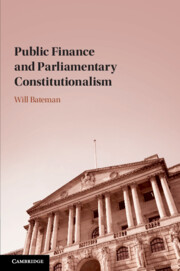Book contents
- Public Finance and Parliamentary Constitutionalism
- Public Finance and Parliamentary Constitutionalism
- Copyright page
- Dedication
- Contents
- Figures
- Preface
- Acknowledgements
- Notes on the Text
- Abbreviations
- 1 Finance and Constitutionalism
- Part I Historical Development of Parliamentary Public Finance
- Part II Parliamentary Public Finance in Operation
- 6 Fiscal Authority
- 7 Debt and Monetary Authority
- 8 Judicial Power
- Part III Evaluating Parliamentary Public Finance
- Bibliography
- Index
7 - Debt and Monetary Authority
from Part II - Parliamentary Public Finance in Operation
Published online by Cambridge University Press: 16 September 2020
- Public Finance and Parliamentary Constitutionalism
- Public Finance and Parliamentary Constitutionalism
- Copyright page
- Dedication
- Contents
- Figures
- Preface
- Acknowledgements
- Notes on the Text
- Abbreviations
- 1 Finance and Constitutionalism
- Part I Historical Development of Parliamentary Public Finance
- Part II Parliamentary Public Finance in Operation
- 6 Fiscal Authority
- 7 Debt and Monetary Authority
- 8 Judicial Power
- Part III Evaluating Parliamentary Public Finance
- Bibliography
- Index
Summary
This chapter provides a case study analysis of the operation of public finance law concerning sovereign debt and monetary finance in the UK and Australia between 2005 and 2016. The legal and financial mechanics of sovereign borrowing and monetary finance are closely examined by reference to the authority of central banks and treasuries to finance the state beyond the point of fiscal deficit. The very broad powers delegated to treasuries over sovereign debt are scrutinised in the context of vastly different economic conditions, and their capacity to shrink the financial authority held by parliaments is observed. Special attention is then given to the monetary financing powers of central banks, particularly the Bank of England. The emergency monetary finance provided by the Bank of England during the financial crisis is surveyed, and the public financing aspect of 'unconventional' monetary policy, particularly quantitative easing, is examined. The chapter closes by observing the absence of meaningful legislative governance of debt and monetary finance in the context of financial or economic emergencies.
Keywords
- Type
- Chapter
- Information
- Public Finance and Parliamentary Constitutionalism , pp. 151 - 170Publisher: Cambridge University PressPrint publication year: 2020

